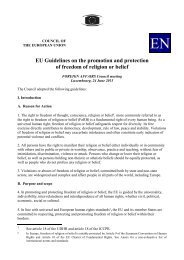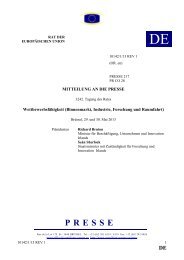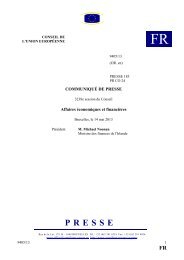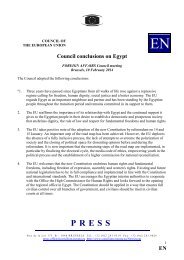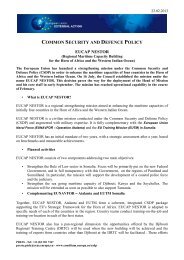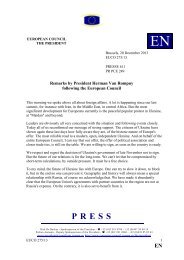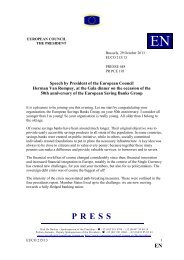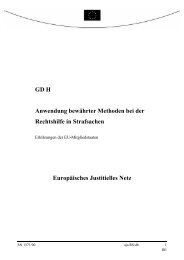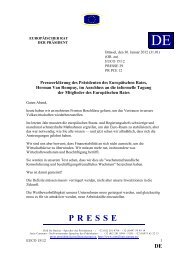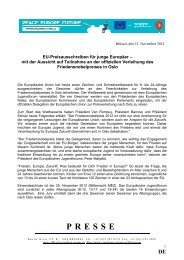14508/09 ADD 1 PL/vk 1 DG G COUNCIL OF THE ... - Europa
14508/09 ADD 1 PL/vk 1 DG G COUNCIL OF THE ... - Europa
14508/09 ADD 1 PL/vk 1 DG G COUNCIL OF THE ... - Europa
You also want an ePaper? Increase the reach of your titles
YUMPU automatically turns print PDFs into web optimized ePapers that Google loves.
4.1.3. Trends emerging from EU-wide data<br />
Indicator 1: Both income inequality and poverty have risen over the past 20 years (OECD 20<strong>09</strong>).<br />
The rise has been significant and widespread, affecting more than three-quarters of OECD<br />
countries. However, note that ‘poverty’ here is a relative concept. In the context of EU 27 the level<br />
of the at-risk-of-poverty threshold in the recently acceded Member States is low compared to the<br />
EU average. A poor person in the UK has more money than a poor Polish person, for example.<br />
Countries with high income inequality tend to have more widespread income poverty, although this<br />
does not always go hand-in-hand. Data clearly show that a significant number of people in the EU<br />
live at risk of poverty. 16 % of Europeans, or 79 million people, were at risk of poverty in 2007. As<br />
for the gender distribution, around 17 % of women and 15 % of men in the EU were at risk of<br />
poverty in 2007.<br />
Poverty risk varies with age. Children (0-17 years) and the elderly (65- years) are more vulnerable<br />
than persons aged 18-64. A substantial shift in poverty has taken place; children and young adults<br />
are today more likely to be poor than the population as a whole, while they were below or close to<br />
the average 20 years ago in the OECD countries. The higher risk of poverty for children than for<br />
working age adults can be explained by the fact that some children live with a single parent – a<br />
category which has grown substantially – and others in families with many children. In both cases<br />
the risk of poverty is bigger. However, there is no reason to expect a gender gap among children<br />
since they are supported by their parents and the proportion of boys and girls can be expected to be<br />
the same in low as in high-income, in single parent and two-parent families.<br />
The risk of poverty is smallest among working age adults and the differences between the countries<br />
are not big (Eurostat, EU-SILC, 2007). In four countries the risk of poverty is actually smaller for<br />
women than for men (FI, <strong>PL</strong>, RO, SE) and in two the risk is the same (DE, SI). In remaining<br />
countries the risk of poverty is bigger for women than for men. The difference is biggest in Malta<br />
and Cyprus (-4 %). However, it should be noted that the result in this age group to a high extent is<br />
the result of the way the at-risk-of-poverty rate is measured; i.e. the assumption that household<br />
resources are pooled. This means that married/cohabiting women and men in households are<br />
assumed to share the resources and that their incomes are therefore of the same size. The reason<br />
why there is a gender gap at all is that there are also single women and men, and single women tend<br />
to have lower incomes than men.<br />
<strong>14508</strong>/<strong>09</strong> <strong>ADD</strong> 1 <strong>PL</strong>/<strong>vk</strong> 51<br />
ANNEX <strong>DG</strong> G EN



